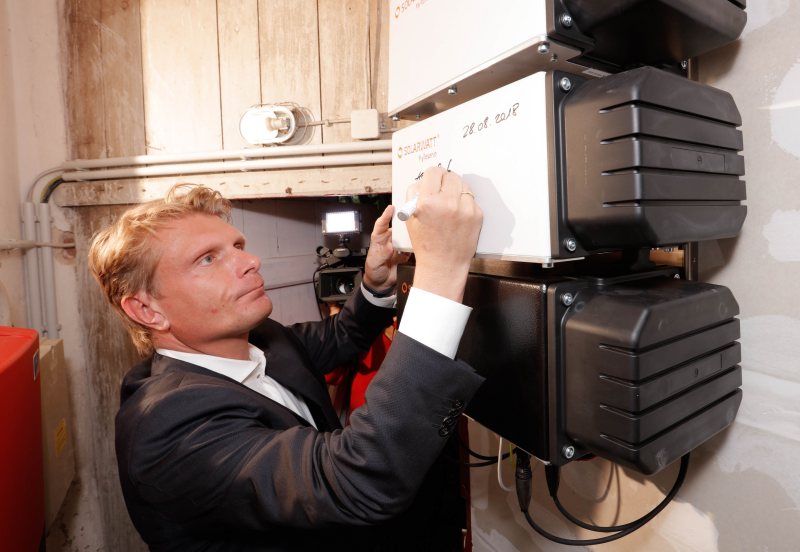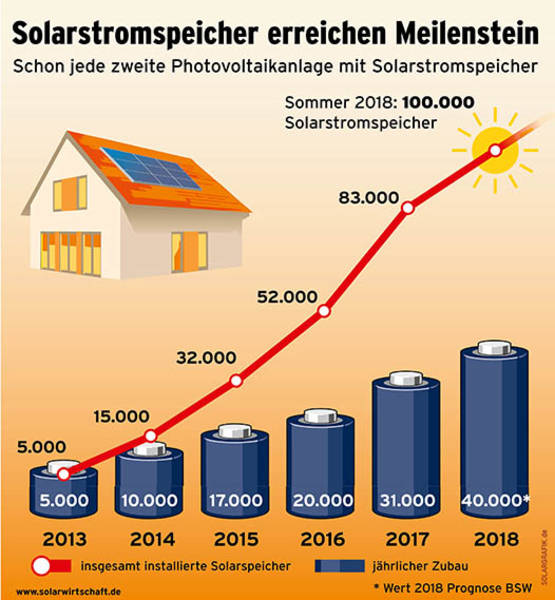
Battery system signed by Germany’s Federal Minister of Economics and Energy, Thomas Bareiß | Image: BSW Solar
Germany has reached another important milestone in its Energiewende (energy transition), the official commissioning of its 100,000th solar battery storage system.
As it was with solar feed in tariffs, Germany has been a pioneer in supporting home energy storage.
In 2014, subsidies for batteries were introduced and while that scheme was to be wound up in 2016 due to funds being exhausted, in June last year funding for the program was topped up and has continued through this year. Helping things along with uptake is battery storage costs have dropped by more than 50 percent in Germany since 2013.

“More than half of the photovoltaic system purchasers order a battery storage right away, because they want to achieve a high level of independence and to make a contribution to the energy transition,” (translated) said Carsten Körnig, Managing Director of BSW Solar, the German Solar Industry Association. “With this momentum, we will reach the next milestone, 200,000 solar batteries, in just two years.”
In case you’re curious, the energy storage unit pictured above signed by Minister Bareiß is a SolarWatt MyReserve Matrix, details of which are listed on SQ’s solar battery storage comparison page.
Battery Storage Uptake In Australia
The latest information from Australia’s Clean Energy Regulator indicates just under 10,000 solar battery storage systems had been installed with new PV installations in Australia as at 31 July. However, the Regulator has previously acknowledged that not all installations are reported and its figures also don’t include retrofitted batteries. The lack of accurate figures has led to the proposed development of a National Battery Register.
Solar industry analysts SunWiz earlier this year put the number of behind-the-meter energy storage systems installed last year in Australia at 21,000.
Appetite for concurrent solar power + storage installations still doesn’t appear to be as great in Australia as it is in Germany. According to the most recent SolarQuotes auSSII report, in July 2018 just under 10% of Australians using our service requested pricing on a concurrent solar panel + battery system installation.
The most recent Electricity Statement of Opportunities (ESOO) from the Australian Energy Market Operator (AEMO) released this month has revised downward projected uptake of battery storage.
“Across the NEM, uptake of business and residential behind-the-meter battery systems by the end of the 20-year outlook period is forecast to be 2.6 gigawatts (GW), less than half the level of uptake projected in 2017 ESOO (5.7 GW).”
The AEMO stated this was due to various factors, including lower forecast retail electricity prices leading to a longer payback period on batteries.
Whether the forecast electricity electricity price decreases materialise and outpace reductions in storage costs remains to be seen.

 RSS - Posts
RSS - Posts



Whilst the report refers to Germanu having a total estimated number of battery storage installations of 100,000, and Australia having a total estimated number of storage batter installations of 21.000, and thence makles the judgement “Appetite for concurrent solar power + storage installations still doesn’t appear to be as great in Australia as it is in Germany”.
Does Germany have the same population, and, the same number of dewllings, as Australia?
A more appropriate comparison of the “Appetite for concurrent solar power + storage installations”, would compare either the number per 1000 population, or, the number per 1000 dwellings, or, both.
Then, and, only then, would such a judgement of the compared numbers, be valid.
To answer your question very simplistically, Germany has a population of about 82 million, compared to Australia’s 25 million. That is more than 3 times as many people. So proportionally, the difference is not as wild.
That said, there probably is an argument to introduce subsidies for battery systems. Purely taking the edge off peak demand after the sun sets would probably make an appreciable difference to wholesale prices.
I was comparing the statement “more than half of the photovoltaic system purchasers order a battery storage *right away*” in Germany with what we’re seeing here on SolarQuotes in terms of *concurrent* solar power + storage installation interest as a percentage as mentioned.
Is that because solar quotes tells it’s clients not to buy batteries yet and so they are not asking for one ?
Hi Martin
I tell people a battery won’t save them money yet. But I don’t tell people not to buy a battery if they want one anyway.
And this is an example of why every home in Australia should have backup battery storage for at least a day’s consumption, and, why it should be subsidised by government:
”
Wind causes blackouts across Adelaide after record warm night
By Daniel Keane and Sarah Scopelianos
Posted August 30, 2018 13:21:21 | Updated August 30, 2018 18:18:53
More than 25,000 homes and businesses in Adelaide lose power after severe winds cross the state, bringing down trees and power lines and blowing roofs off houses.
”
And, I think some Solar Quotes people happen to be based somewhere in that vicinity…
I’m in Adelaide (or next to it) and no lights out where I am. But I was told some traffic lights were out. Those things should definitely have battery backup. My gut feeling is the improvement in safety would have to be worth it.
The bright side of strong winds is the wholesale price of electricity was around nothing for 3 hours last night thanks to good wind farm output.